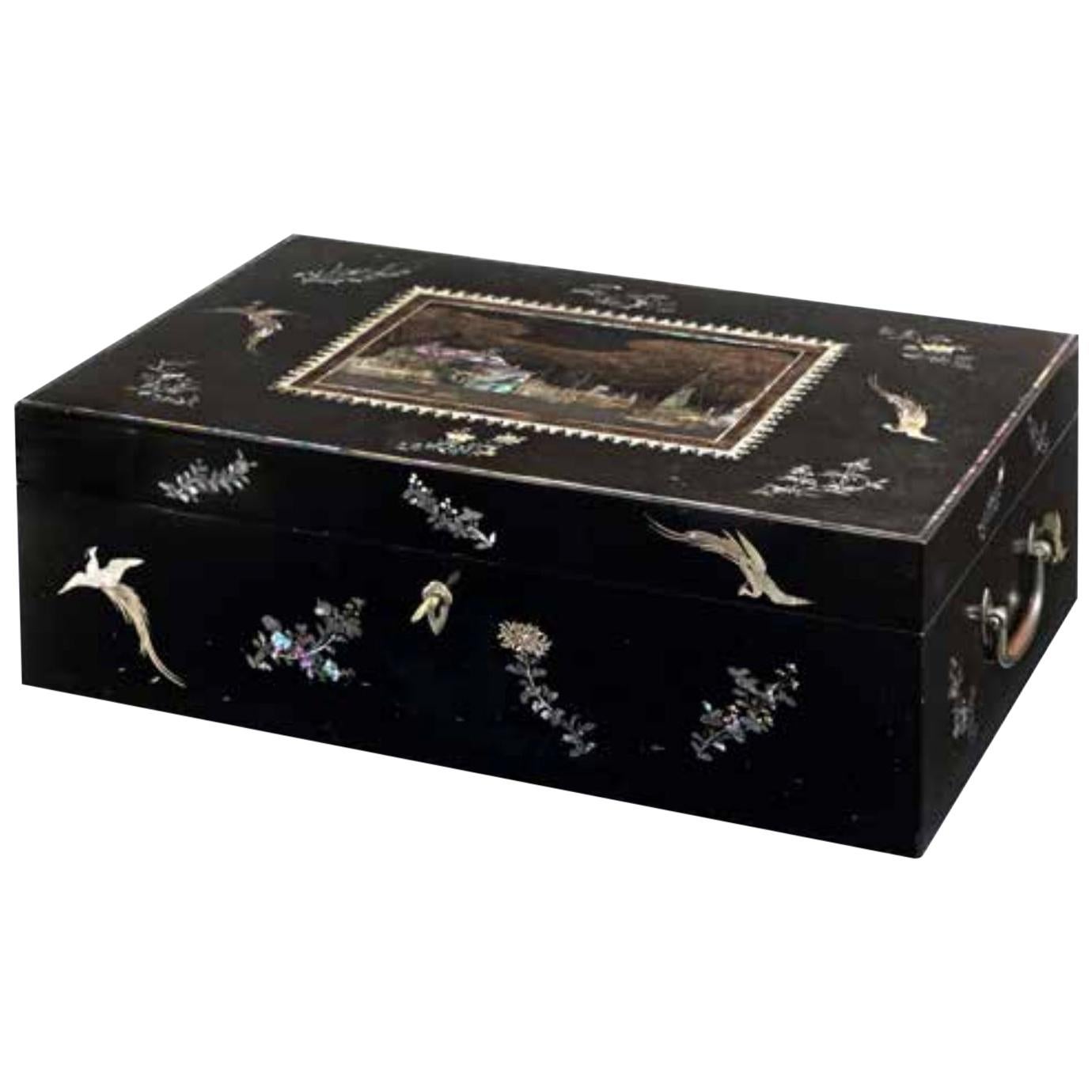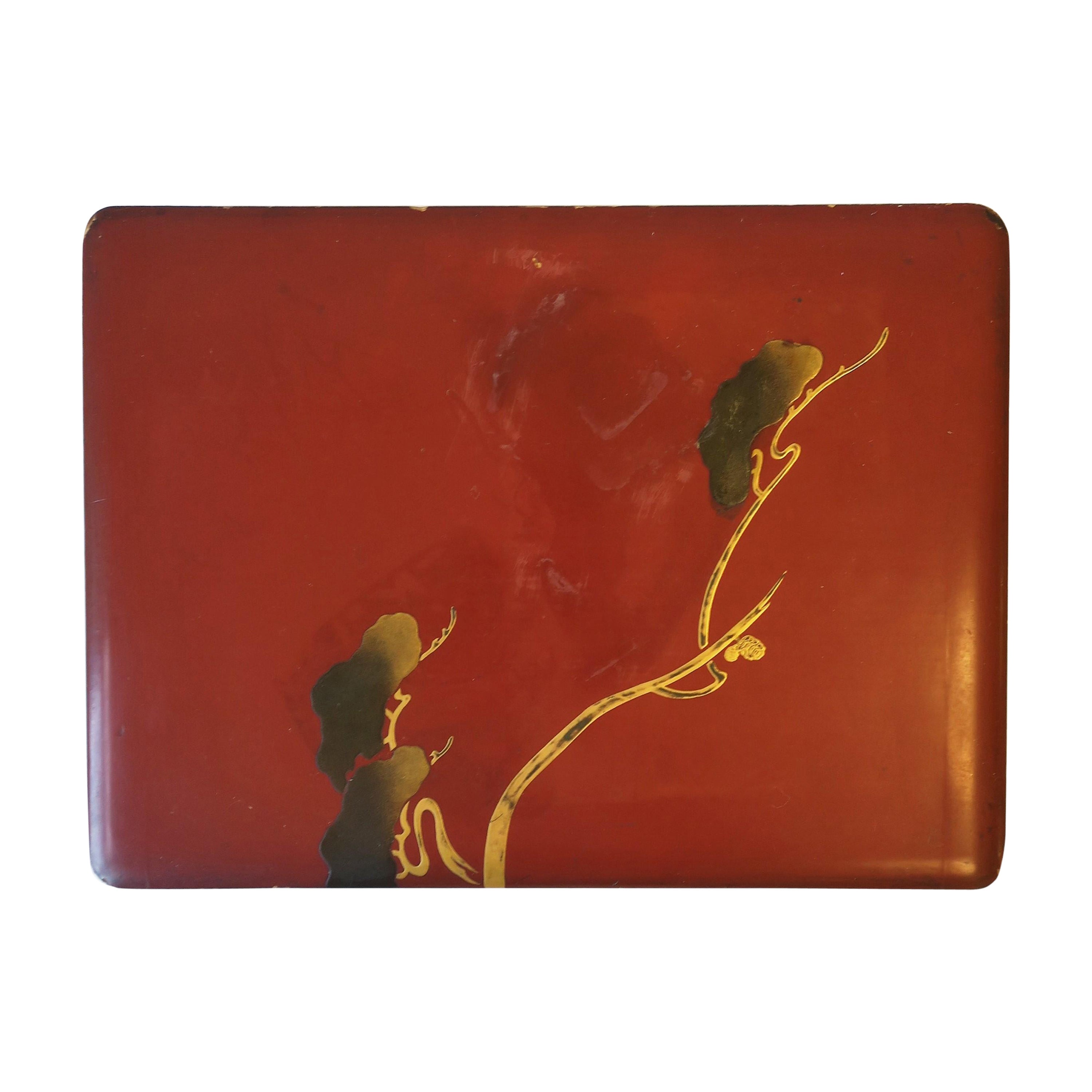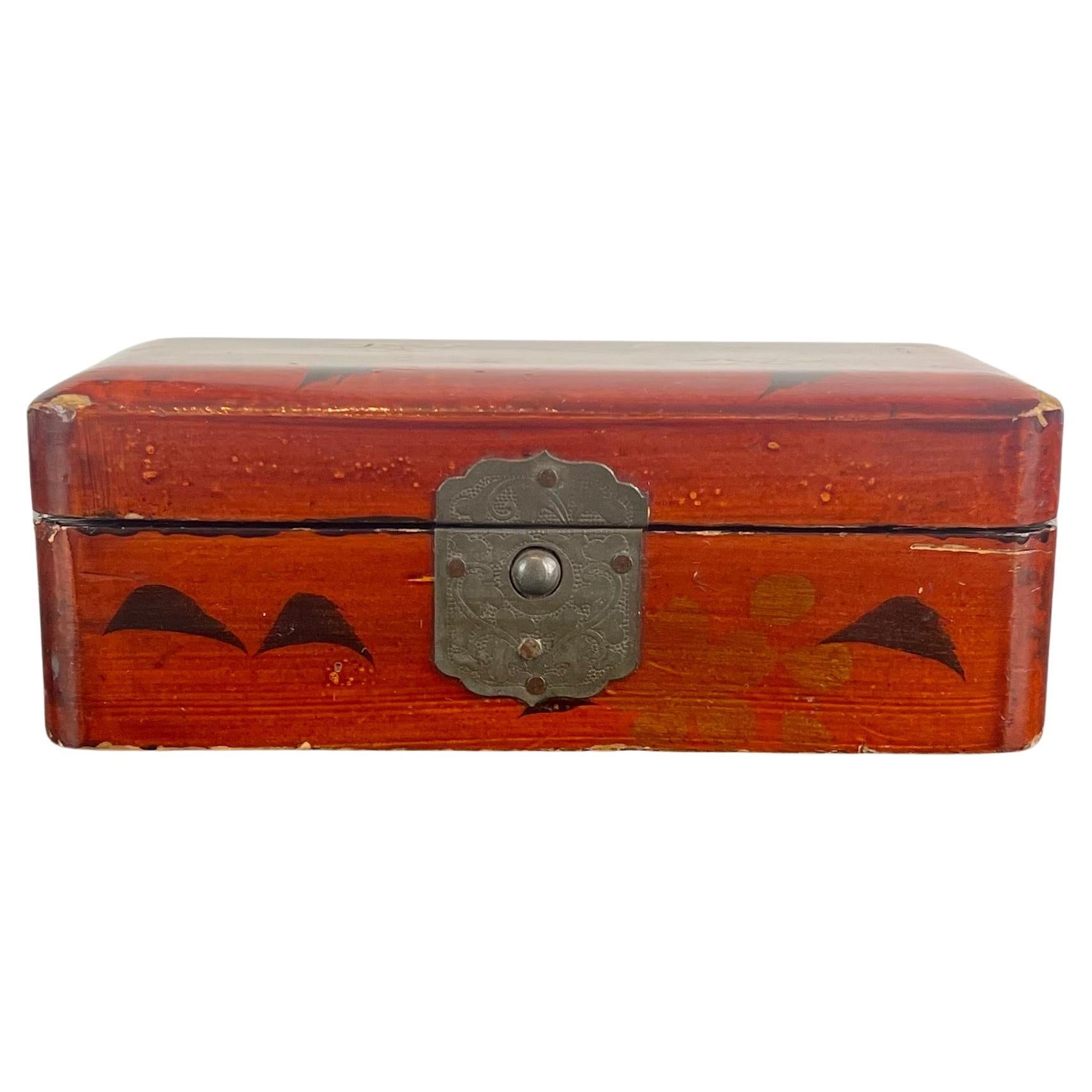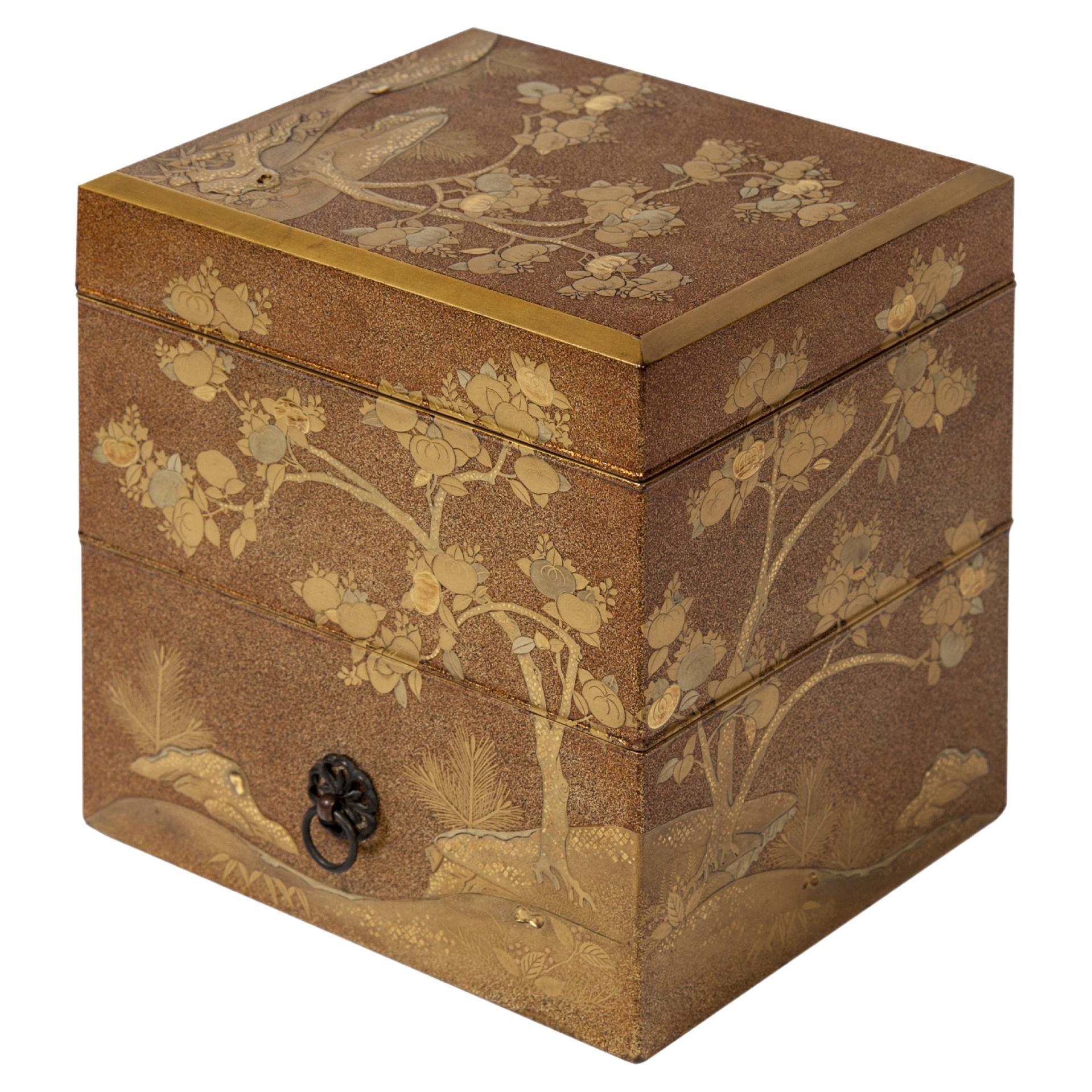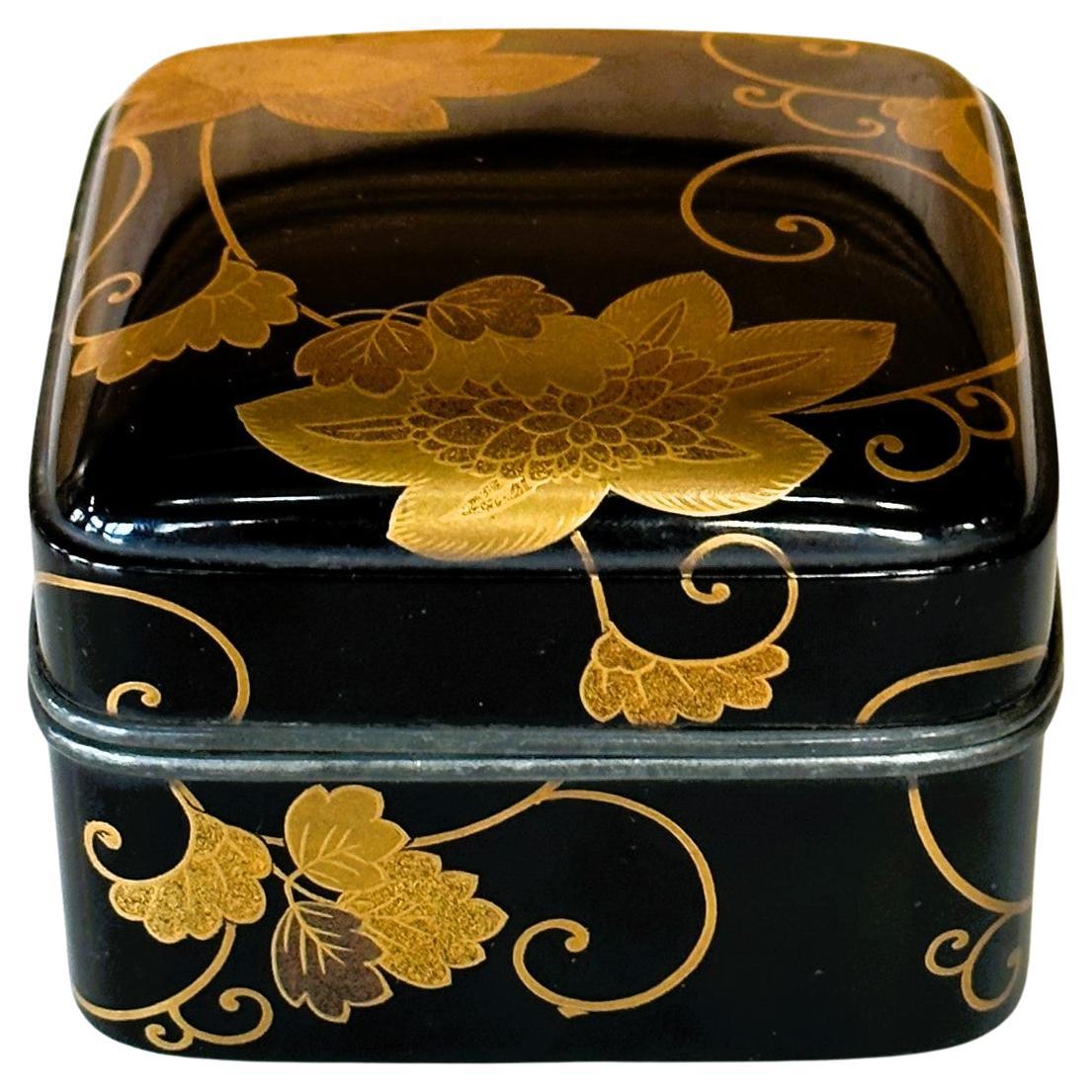Items Similar to Japanese Nagasaki Export Lacquer Box with Depiction of the 'Trippenhuis'
Want more images or videos?
Request additional images or videos from the seller
1 of 7
Japanese Nagasaki Export Lacquer Box with Depiction of the 'Trippenhuis'
About the Item
A Japanese Nagasaki export lacquer box with mother-of-pearl depiction of the Amsterdam ‘Trippenhuis’
Edo-period, circa 1830
H. 12.5 x W. 24 x D. 15 cm
?
The house depicted on the lid is Het Trippenhuis, a neo-classical mansion on the Kloveniersburgwal in Amsterdam, based on a print ‘Gezicht op Klovenierswal ‘t Huis van de Heer Burgemeester Trip; en St Anthoniswaag’ from circa 1750, after a painting by Gerrit Adriaensz Berkheyde dated 1685.
Het Trippenhuis was built in 1660-1662 for the wealthy Amsterdam arms-dealers Louis and Hendrik Trip, by architect Justus Vingboons, who behind a single facade built two houses.
In 1812, Het Koninklijk Instituut van Wetenschappen, Letterkunde en Schoone Kunsten, established by King Louis Napoleon in 1808, moved into the house. After 1815, when the Netherlands were ruled by King William I, the name was changed to Het Koninklijk-Nederlands Instituut van Wetenschappen, Letterkunde en Schoone Kunsten, the predecessor of the Rijksmuseum. The famous painting De Nachtwacht by Rembrandt hung there until it was moved to the new Rijksmuseum in 1885. The present box probably was ordered by someone connected to, or was a gift intended for, the institute.
- Dimensions:Height: 4.93 in (12.5 cm)Width: 9.45 in (24 cm)Depth: 5.91 in (15 cm)
- Style:Edo (In the Style Of)
- Materials and Techniques:
- Place of Origin:
- Period:
- Date of Manufacture:Circa 1830
- Condition:Wear consistent with age and use.
- Seller Location:Amsterdam, NL
- Reference Number:1stDibs: LU5458233886942
About the Seller
5.0
Vetted Seller
These experienced sellers undergo a comprehensive evaluation by our team of in-house experts.
Established in 1985
1stDibs seller since 2020
19 sales on 1stDibs
Typical response time: 2 hours
- ShippingRetrieving quote...Ships From: Amsterdam, Netherlands
- Return PolicyA return for this item may be initiated within 7 days of delivery.
More From This SellerView All
- Japanese Export Nagasaki Lacquer Box with the Portrait of Napoleon BonaparteLocated in Amsterdam, NLA Japanese export Nagasaki lacquer tobacco box with the portrait of Napoleon Bonaparte Edo-period, circa 1810 The box in black lacquer on copper, ...Category
Antique 19th Century Japanese Edo Lacquer
MaterialsCopper, Gold
- Fine Japanese Export Red Lacquer Box with Masonic Symbols, circa 1800Located in Amsterdam, NLA fine Japanese export red lacquer box with Masonic symbols Kyoto/Nagasaki, 1800-1820 Red lacquer decorated with scattered flowers and flying birds with long tails in gold, wit...Category
Antique Early 19th Century Japanese Edo Lacquer
MaterialsGold
- Japanese Colonial Nagsaki Lacquer Box with Depiction of Amsterdam, 1830-1840Located in Amsterdam, NLAn important Japanese lacquer box with a view of The 'Nieuwe Stadsherberg Van Amsterdam Nagasaki, Edo-period, 1830-1840 The black lacquered wood box, decorated in gold and inla...Category
Antique Early 19th Century Japanese Decorative Boxes
MaterialsMother-of-Pearl, Wood
- A Japanese export lacquer box with depiction of the Grand Hotel, YokohamaLocated in Amsterdam, NLMeiji period, circa 1873-1887 The black lacquered box decorated in maki-e and hiramaki-e gold, with on the lid a European style building complex and several Japanese and European figures walking along a street in the foreground. The sides are finely decorated with several insects and the inside with several compartments and nashiji decoration. H. 7.4 x W. 29 x D. 25.7 cm After the Americans forced Japan to open their harbours to the outside world and take part in international treaty and trade around the mid 19th century, the formerly feudal society rapidly changed. Japan was now focussing on an industrial future. One of the major international ports was Yokohama with its foreign embassies and warehouses - which attracted a great number of visitors of all sorts. For the higher society visiting Japan for the first time a new and ‘Western’ hotel had to be realised; hence the construction of The Grand Hotel on Kaigandori. The hotel was opened on August 16, 1873 (Meiji 6) and was soon considered the height of Western culture and elegance in Japan. The building probably depicted on this box, designed by American architect Richard P. Bridgens (リチャード・ブリジェンス, 1819 -1891), is the original hotel...Category
Antique 19th Century Japanese Lacquer
MaterialsGold
- 17th Century Japanese Export Lacquer Cabinet with Depiction the Dutch TradepostLocated in Amsterdam, NLA highly important Japanese export lacquer cabinet with depiction of the Dutch East India Company tradepost Deshima and the annual Dutch delegation on its way to the Shogun in Edo Edo period, circa 1660-1680 H. 88 x W. 100.5 x D. 54 cm This cabinet includes a later European japanned stand, but also a modern powder-coated steel frame. The latter can be designed and added to your specific needs. The sides and front of the rectangular two-door cabinet are embellished in gold and silver hiramaki-e and takamaki-e on a black roiro lacquer ground with a continuous design. The two doors depict a long procession of numerous figures travelling on foot and horseback along buildings and a pagoda into a mountainous landscape. This is the annual court journey, Hofreis, of the Dutch from Nagasaki to the Shogun’s court in Edo. Three horseback riders are dressed as Dutch merchants and a fourth figure, probably het Opperhoofd, is seen inside a palanquin, norimon. Just about to cross the bridge, two men are carrying a cabinet like the present one. Many Japanese figures on either side of the procession are engaged in various activities; some play musical instruments on board of small boats, others are fishing; figures inside buildings are depicted playing go, and farmers are tending to their rice paddocks. The upper part of the right door shows a large mansion, probably the local daimyo’s castle, with men kneeling before a man in the central courtyard. The court journey fits in with the foreign policy of the shogunate which accorded a role to the VOC alongside China, Korea, and the Ryukyu Islands who also had to pay tribute. However, the VOC employees were traders, having low status in Japan’s social hierarchy, and they were received with less deference than were the state embassies from Korea and the Ryukyu Islands. Nevertheless, the contacts with the Dutch were a welcome source of information to the Shogun about Europe and European science and technology. The left side of the cabinet depicts, in mirror image, a rare view of the artificial fan-shaped Deshima Island, the trading post for the Dutch in Japan. The island, where the Dutch flag flies, is surrounded by small Japanese boats and an anchored three-masted fluyt (cargo ship), flying Dutch flags, with on the stern the VOC monogram. On the bottom right a busy street of Nagasaki is shown, bordered by shops and leading up to the stone bridge. On the island the trees are beautifully painted, two cows can be seen, and the flagpole, all in very fine detail. Dutchmen and enslaved Malay are visible outside the buildings and two Japanese figures, probably guards, sit in a small hut in the centre. A maximum of fifteen to twenty Dutchmen lived on the island at any time and soldiers or women were not allowed. Restrictions on Deshima were tight, and the merchants were only allowed to leave the island by special permission. The Opperhoofd had to be replaced every year, and each new Opperhoofd had to make a court journey to pay tribute, present gifts, and to obtain permission to Margaret Barclay eep on trading. In the distance, many birds fly above the hills and a four-story pagoda can be seen. The right side of the cabinet is painted with other horse riders and their retinue journeying through mountains. The pair of doors to the front open to reveal ten rectangular drawers. The drawers are decorated with scenes of birds in flight and landscapes with trees and plants. The reverse of the left door with two thatched buildings, one with a ladder, underneath a camelia tree with large blooms; the right door with a three-story pagoda nestled among trees and both doors with a flying phoenix, ho-oo bird. The cabinet, with elaborately engraved gilt copper mounts, hinges, lock plates and brass handles, is raised on an 18th-century English japanned wood stand. A pair of large cabinets...Category
Antique 17th Century Japanese Edo Lacquer
MaterialsCopper, Gold
- Superb Late 16th Century Signed Colonial Japanese Namban Export Lacquer CofferLocated in Amsterdam, NLSuperb late 16th century signed colonial Japanese Namban export lacquer coffer Momoyama period, late 16th/early 17th century, inscribed 'Arisato' on the bottom H. 30.5 x W. 43...Category
Antique 16th Century Japanese Lacquer
MaterialsCedar, Lacquer
You May Also Like
- Japanese Lacquer BoxLocated in New York, NYA Japanese red burgundy, gold and black lacquer box with round corners and silk cloth interior lining, circa early-20th century, 1920s, Japan. Box was desi...Category
Early 20th Century Japanese Decorative Boxes
MaterialsWood, Silk
- Small red lacquered Japanese box with royal motto of the Netherlands, 1880Located in Beuzevillette, FRPretty little Japanese lacquered box. On a golden metal medal inside we can read the royal motto of the Netherlands, adorned with a lion: "Je maintiendrai...Category
Antique Late 19th Century Japanese Decorative Boxes
MaterialsWood
- Japanese Lacquered Tebako 'Box'Located in PARIS, FRTebako box with three compartments in golden and nashi-ji lacquer, decorated with golden, red, and kirigane lacquer, golden persimmon tree leaves, among rocks. The compartments are of increasing size from the top. The decoration is in continuity. Persimmon has been cultivated in southern China for more than 2500 years and is believed to have been introduced to Japan in the 8th century. The veneer is a tree with very hard wood, similar to ebony. According to a legend, one specimen survived the atomic bombing of Nagasaki on August 9, 1945, close to the epicenter. It is therefore in Japan a symbol of strength and longevity. It is also the national fruit of the country. It is eaten as a traditional dish during New Year's Day celebrations. Tebako literally means "portable box...Category
Antique 1860s Japanese Lacquer
MaterialsLacquer
- Antique Japanese Lacquered Incense Box Kobako in Kodaiji StyleLocated in Atlanta, GAAn antique lacquered small box that was likely used to contain incense powder (it is called Kobako in Japanese), circa early to mid-19th century of the Edo...Category
Antique 19th Century Japanese Edo Lacquer
MaterialsWood, Lacquer
- Japanese Lacquered Furoshiki Kobako 'Box'Located in PARIS, FRRectangular and flat lacquer Kobako (small box) representing a furoshiki knot seen from above. Fundame background, furoshiki in takamaki-e with floral pattern, inside the folds of the fabric with black and gold sayagata pattern with togidashi maki-e technique. The saya (or sayagata) pattern is composed of Chinese swastikas...Category
Antique Late 19th Century Japanese Lacquer
MaterialsLacquer
- Japanese Lacquered Natsume 'Tea Box'Located in PARIS, FRNatsume in dark red lacquer, decorated with autumn leaves and cherry blossoms in hiramaki-e and nashiji. Interior in black lacquer. Maple leaves (Momiji) are celebrated in literatur...Category
Mid-20th Century Japanese Lacquer
MaterialsLacquer
Recently Viewed
View AllMore Ways To Browse
Japanese Antique Bento
Vintage Japanese Bento Box
Japanese Tanzaku
Suzuki Silver
Burmese Lacquerware Betel Box
Burmese Yun
Chinese Chippendale Jewelry Box
Manju Netsuke
Pagan Bya
Temple Ranma Panel
Antique Korean Black Lacquer Mother Of Pearl
Chinese Enamel Smoking Set
Japanese Lacquer Inro Bag
Peranakan Mirror
Rabbit Netsuke Ojime
Sake Storage Container
Vintage Presentation Kimono
Lacquered R Wardrobe

